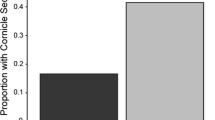Abstract
The sesquiterpene, (E)-β-farnesene, is used by many aphid species as an alarm pheromone to warn related individuals of predation. Disturbed cotton aphids, Aphis gossypii Glover, released (E)-β-farnesene into the air as detected by solid phase microextraction and gas chromatography mass spectrometry (GC–MS). Solvent extracts of cotton aphids of various life stages and weights also were analyzed by GC–MS for sums of ions 69 and 93, which discriminated (E)-β-farnesene from coeluting compounds. Aphids of all life stages and sizes reared on cotton plants in both an environmental chamber and glasshouse contained (E)-β-farnesene in amounts ranging from 0.1 to 1.5 ng per individual. The quantities of (E)-β-farnesene in aphids increased in relation to increasing body weight, and variation in individual weights explained about 82% of the variation in alarm pheromone. However, the concentrations (ng/mg fresh weight) declined exponentially with increasing body weight. These findings indicate that aphid nymphs try to compensate for their smaller size by producing relatively more pheromone per weight than adults but still cannot approach an evolutionary optimal load, as assumed in adults with the greatest total amounts. This suggests that young aphids need to balance costs of growth and maturation with costs of producing the alarm pheromone.



Similar content being viewed by others
References
Baker TC (1989) Sex pheromone communication in the Lepidoptera: new research progress. Experientia 45:248–262
Birgersson G, Schlyter F, Bergström G, Löfqvist (1988) Individual variation in aggregation pheromone content of the bark beetle, Ips typographus. J Chem Ecol 14:1737–1761
Bowers WS, Nault LR, Webb RE, Dutky SR (1972) Aphid alarm pheromone: isolation, identification, synthesis. Science 177:1121–1122
Byers JA (1989) Chemical ecology of bark beetles. Experientia 45:271–283
Byers JA, Anderbrant O, Löfqvist J (1989) Effective attraction radius: a method for comparing species attractants and determining densities of flying insects. J Chem Ecol 15:749–765
Edwards LJ, Siddal JB, Dunham LL, Uden P, Kislow CJ (1973) Trans-β-farnesene, alarm pheromone of the green peach aphid, Myzus persicae (Sulzer). Nature 241:126–127
El-Sayed AM (2004) The pherobase: database of insect pheromones and semiochemicals. http://www.pherobase.com
Gut J, Van Oosten AM (1985) Functional significance of the alarm pheromone composition in various morphs of the green peach aphid, Myzus persica. Entomol Exp Appl 37:199–204
Hedin PA, Phillips VA, Dysart RJ (1991) Volatile constituents from honeysuckle aphids, Hyadaphis tataricae, and the honeysuckle, Lonicera spp.: search for assembling pheromones. J Agric Food Chem 39:1304–1306
Kislow CJ, Edwards LJ (1972) Repellent odours in aphids. Nature 235:108–109
Mondor EB, Roitberg BD (2000) Has the attraction of predatory coccinellids to cornicle droplets constrained aphid alarm signaling behavior? J Insect Behav 13:321–329
Montgomery ME, Nault LR (1977) Comparative response of aphids to the alarm pheromone, (E)-β-farnesene. Entomol Exp Appl 22:236–242
Nault LR, Bowers WS (1974) Multiple alarm pheromones in aphids. Entomol Exp Appl 17:455–457
Nault LR, Edwards LJ, Styer WE (1973) Aphid alarm pheromones: secretion and reception. Environ Entomol 2:101–105
Pickett JA, Griffiths DC (1980) Composition of aphid alarm pheromones. J Chem Ecol 6:349–360
Pickett JA, Wadhams LJ, Woodcock CM, Hardie J (1992) The chemical ecology of aphids. Annu Rev Entomol 37:67–90
Sappington TW, Taylor OR (1990) Developmental and environmental sources of pheromone variation in Colias eurytheme butterflies. J Chem Ecol 16:2771–2786
Schlyter F (1992) Sampling range, attraction range, and effective attraction radius: estimates of trap efficiency and communication distance in coleopteran pheromone and host attractant systems. J Appl Entomol 114:439–454
Sokal RR, Rohlf FJ (1995) Biometry, 3rd edn. Freeman, New York
Wientjens WHJM, Larwijk AC, Van Der Marel T (1973) Alarm pheromone of grain aphids. Experientia 29:658–660
Wohlers P (1982) Effect of alarm pheromone (E)-β-farnesene on aphid behaviour during flight and after landing on plants. Z Angew Entomol 93:102–108
Author information
Authors and Affiliations
Corresponding author
Rights and permissions
About this article
Cite this article
Byers, J.A. A cost of alarm pheromone production in cotton aphids, Aphis gossypii. Naturwissenschaften 92, 69–72 (2005). https://doi.org/10.1007/s00114-004-0592-y
Received:
Accepted:
Published:
Issue Date:
DOI: https://doi.org/10.1007/s00114-004-0592-y




